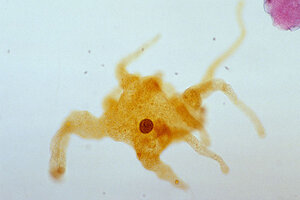Deepest ocean trench home to race of giant amoebas
Scientists have discovered a community of 4-inch amoebas living at the bottom of the Mariana Trench, the deepest known part of the world's oceans.

Imagine one of these guys, but more than 100 times bigger. That's what scientists found at the bottom of the Mariana Trench, the deepest known part of the world's oceans.
Mike Peres RBP SPAS "CMSP Biology"/Newscom
During a July 2011 voyage to the Pacific Ocean chasm, researchers with Scripps Institution of Oceanography at UC San Diego and National Geographic engineers deployed untethered landers, called dropcams, equipped with digital video and lights to explore the largely mysterious region of the deep sea.
The team documented the deepest known existence of xenophyophores, single-celled animals exclusively found in deep-sea environments. Xenophyophores are noteworthy for their size, with individual cells often exceeding 4 inches (10 centimeters), their extreme abundance on the seafloor and their role as hosts for a variety of organisms.
Extreme environment, extreme creature
The researchers spotted the life forms at depths up to 6.6 miles (10,641 meters) within the Sirena Deep of the Mariana Trench. The previous depth record for xenophyophores was approximately 4.7 miles (7,500 m) in the New Hebrides Trench, although sightings in the deepest portion of the Mariana Trench have been reported. [Infographic: Tallest Mountain to Deepest Ocean Trench]
Scientists say xenophyophores are the largest individual cells in existence. Recent studies indicate that by trapping particles from the water, xenophyophores can concentrate high levels of lead, uranium and mercury and are thus likely resistant to large doses of heavy metals. They also are well suited to a life of darkness, low temperature and high pressure in the deep sea.
"The identification of these gigantic cells in one of the deepest marine environments on the planet opens up a whole new habitat for further study of biodiversity, biotechnological potential and extreme environment adaptation," said Doug Bartlett, the Scripps marine microbiologist who organized the expedition.
Tip of the iceberg
The xenophyophores are just the tip of the deep-sea ecosystem iceberg. The expedition also found the deepest jellyfish observed to date, as well as other mysterious animals.
"As one of very few taxa found exclusively in the deep sea, the xenophyophores are emblematic of what the deep sea offers. They are fascinating giants that are highly adapted to extreme conditions but at the same time are very fragile and poorly studied," Levin said. "These and many other structurally important organisms in the deep sea need our stewardship as human activities move to deeper waters."
The dropcams used to observe the creatures contained an HD camera and lighting inside a glass bubble that can withstand the extreme pressures encountered at these depths.
"Seafloor animals are lured to the camera with bait, a technique first developed by Scripps professor John Isaacs in the 1960s," said Kevin Hardy, a Scripps ocean engineer and cruise participant. Hardy advanced the ultra-deep glass sphere design used on 'dropcams' more than a decade ago. "Scripps researchers hope to one day capture and return novel living animals to the laboratory for study in high-pressure aquariums that replicate the trench environment."
